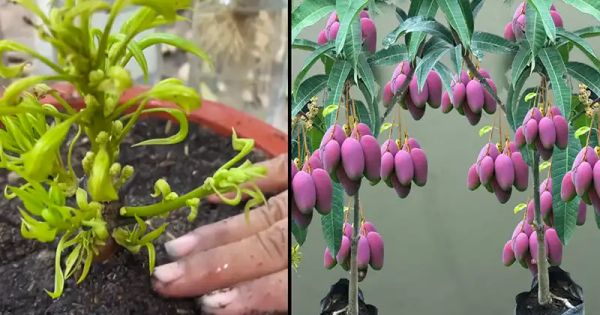Growing your own mango trees can be an exciting and rewarding experience, especially when you can do it from cuttings using the water method. If you’re between the ages of 45 and 65, you might be looking for a fun and engaging project to keep you busy. This step-by-step guide will show you exactly how to propagate mango trees from cuttings using the water method. Get ready to enjoy the delicious fruits of your labor!

What You’ll Need:
- Mango Cuttings: Choose healthy mango cuttings that are about 10-12 inches long. Make sure they have at least two or more nodes, which are the points where leaves and stems grow.
- Sharp Knife or Pruners: For making clean cuts on the mango branches.
- Paper Towels or Tissue Paper: To help with root formation.
- Container with Water: A clean and transparent container, like a glass or plastic container, to hold the cuttings while they develop roots.
- Fresh Water: Use clean, room-temperature water to provide a nurturing environment for the cuttings.
- Indirect Sunlight: Find a location with bright, indirect sunlight. Mango trees love the sun, but direct sunlight can be too intense for the cuttings.
- Well-Draining Potting Mix: This will be needed later when transplanting the rooted cuttings into pots.

Let’s Get Started!
Step 1: Select and Prepare Mango Cuttings
- Choose healthy branches from a mature mango tree. Make sure each cutting has at least two or more nodes.
- Use a sharp knife or pruners to make a clean cut just below a node. This is where the roots will develop.
Step 2: Remove Bark and Apply Paper Towels
- Carefully remove a small section of bark from the bottom 1-2 inches of the cutting. This will help promote root formation.
- Wrap the exposed area with a couple of layers of damp paper towels or tissue paper. This will keep the area moist and encourage root growth.
Step 3: Place Cuttings in Water
- Fill a clean container with room-temperature water.
- Submerge the prepared mango cuttings in the water, making sure that at least one or two nodes are under the water.
Step 4: Change Water Regularly
- Every few days, change the water to prevent stagnation and the growth of algae and bacteria. Fresh, room-temperature water is best.
Step 5: Provide Adequate Light and Warmth
- Find a location with bright, indirect sunlight for the container with the cuttings. Avoid placing them in direct sunlight, as it can harm the cuttings.
- Maintain a warm and consistent temperature, as mangoes prefer warmth for rooting.
Step 6: Wait for Roots to Develop
- Be patient! It can take anywhere from several weeks to several months for roots to start forming.
- Keep an eye on the progress and be sure to give your cuttings the time they need to develop strong and healthy roots.
Step 7: Transplant Rooted Cuttings
- Once the roots are a few inches long and look healthy, it’s time to transplant the cuttings.
- Carefully remove the cuttings from the water and plant each of them in a separate pot filled with well-draining potting mix. Make sure the rooted portion is below the soil surface.
Step 8: Care for Transplanted Mango Trees
- Place the potted mango cuttings in a location with indirect sunlight.
- Water them regularly, keeping the soil consistently moist but not waterlogged.
- As the mango trees grow, gradually expose them to more sunlight for stronger and healthier growth.
Additional Tips for Success:
- To increase your chances of success, take more than one cutting.
- Keep in mind that the success rate of water propagation may vary depending on the health of the cuttings and the specific mango variety.
Growing your own mango trees from cuttings can be a fun and cost-effective way to expand your mango orchard. While it may take some time for the cuttings to develop into mature, fruit-bearing trees, the patience and care you invest will be well worth it. Enjoy the process and share the joy of growing mango trees with your friends!
Inspired by this? Share the article with your friends!




